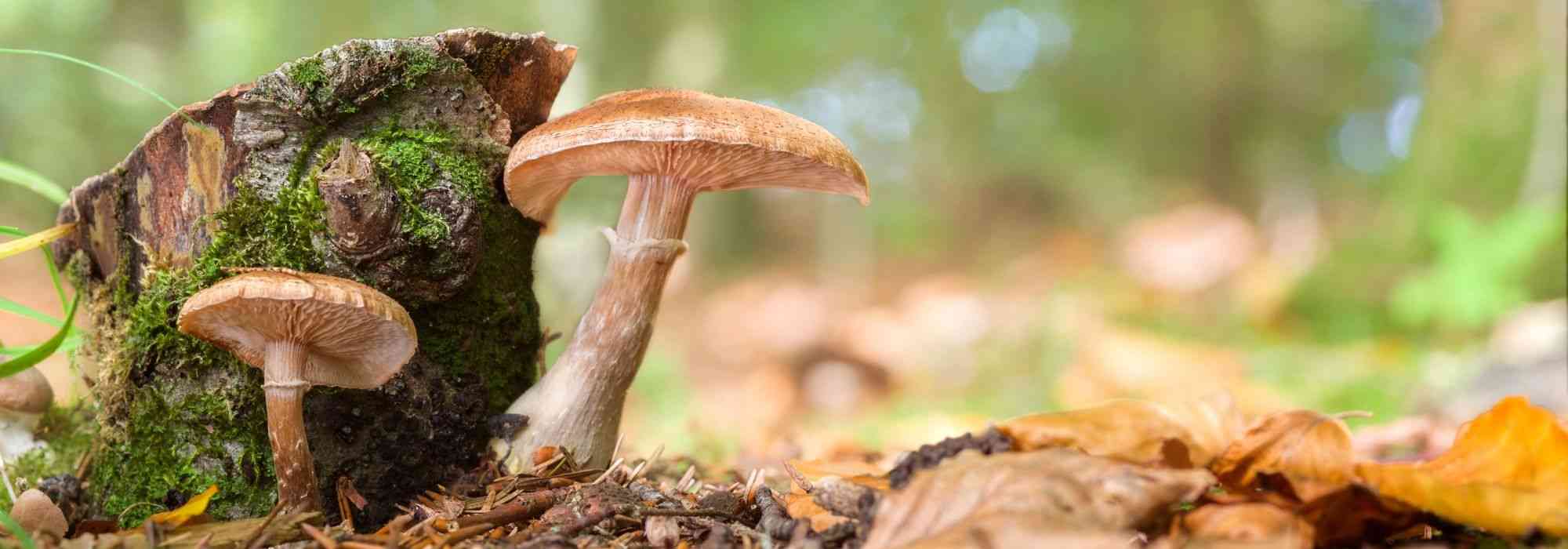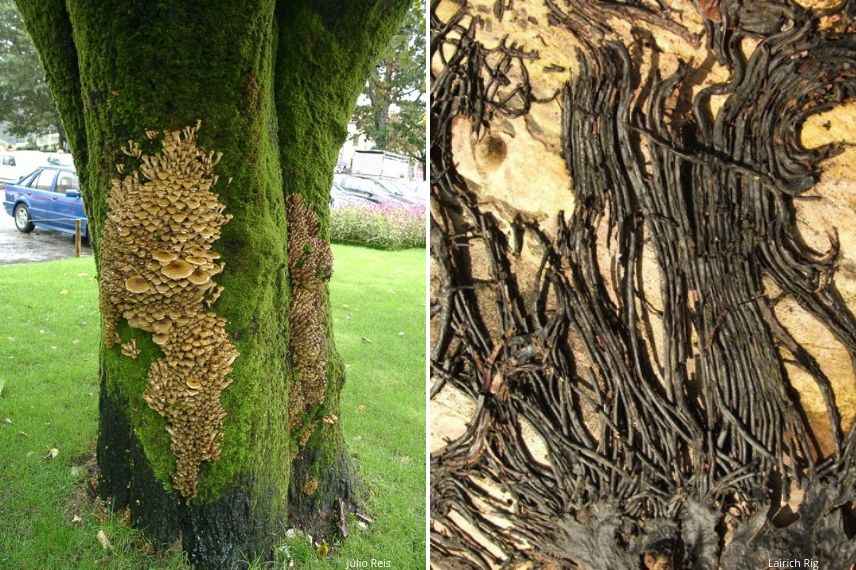
Armillaria or honey fungus: recognise and control this tree fungus
Our tips
Contents
Honey fungus, also known as honey rot or honey-rot agaric is a feared fungus, both in forests and in ornamental gardens.
It attacks many species of trees and often appears at the base of trunks. It is feared because it can act more or less suddenly and leads not only to the death of the tree but also dooms subsequent generations, because the fungus persists in the soil and similarly contaminates neighbouring plants via roots that often interconnect.
The fungus, however, affects plants stressed by drought, insect attack… It is frequently too late once symptoms appear, but cultural measures can prevent its spread.
Which species are susceptible to Armillaria?
Armillaria, long thought to be polymorphous, actually comprises 5 European species of Armillaria :
- Armillea mellea, A. gallica (syn. A. bulbosa) encountered particularly on leafy trees,
- solidipes (syn. A. ostoyae) more frequent on conifers,
- borealis and A. calvescens, on both leafy trees and conifers, noting that all species can affect mixed stands of leafy trees and conifers.
Armillaria root rot infects both leafy trees and conifers, deciduous or evergreen, as well as herbaceous plants and climbing plants such as:
Mulberry, Hornbeam, Pine, Fir, Larch (deciduous conifer), Cedar but also Rose, Peony and more rarely Oak, Beech, etc.
This rather uncommon fungus can wreak serious damage on plants weakened by a wind or ice storm, several years of drought…

Some Armillaria: A. mellea, A. solidipes and A. borealis
Read also
Phytophtora : identify, prevent, controlHow to detect and recognise Armillaria?
Primary mycelium of this cap fungus (order of Basidiomycetes) first develops without visible sign on roots, under bark and at base of trunk.
However, you may be alerted by a very abundant fruiting of the tree which generally precedes imminent death.
Then suddenly leaves and shoots dry out in early summer because of obstruction of sap-conducting vessels. It is unfortunately usually too late to act, especially since the fungus has had plenty of time to spread through soil and contaminate neighbouring plants.
The plant then emits a mouldy smell similar to that of a fungus.
There is another fungus Rosellinia necatrix called “Pourridié wooly” that presents the same symptoms but attacks more specifically Apple, Lavender and Jasmine as well as Carnation, Peony and Violet.
To confirm diagnosis, lift bark at base of trunk to check for presence of white or cream patches arranged in palmate patterns, of primary mycelium (filaments corresponding to the asexual form of the fungus). An entanglement of black cords the size of a shoelace (rhizomorphs) is sometimes visible.
Secondary mycelium, which denotes the fruiting of the fungus, usually appears in autumn as clusters of small cream-white mushrooms with a collar (flocculent-membranous veil) at the level of its thin stem, topped by a honey-coloured cap more or less spreading depending on age and speckled with brown scales, with whitish gills on the underside.
When young plant is pulled up, roots are brown.

Armillaria on trunk of a lime tree and rhizomorphs
Factors promoting root rot
- Newly planted plants, stressed by their new environment, are particularly vulnerable, especially if they are growing near an old infected tree.
- Excess moisture in the soil appears to favour the fungus.
- Honey-coloured honey fungus is also a saprophytic fungus that can feed on dead wood and humus. It also persists in the soil as sclerotia (survival structures) or rhizomorphs that infect the roots of neighbouring trees, so spread occurs in patches across a plot.
- The trees most affected are stressed trees, struck by lightning, suffering severe drought, wounded by drastic pruning (unfortunately far too common in inhabited areas) or by construction work, by frost cracking, by bark detachment caused when the tree sways in a strong gust of wind, etc.
Read also
AnthracnoseControlling and treating Armillaria
To combat root rot:
- Pull out affected young plants, removing as many roots as possible and burn them.
- Dig a 50 cm trench around the planting hole, placing the excavated soil inside the circle and wait a few years before replanting in that spot.
- Alternatively, excavate soil to 60–80 cm in all directions (or more depending on size of specimen) and replace it with fresh soil.
- Remove old stumps likely to harbour fungus.
- If you wish to replant in same spot, choose a plant that is not very susceptible to root rot such as Box, Catalpa, Oak, Beech, Yew, Rowan, Tamarisk, Lime, and favour a young plant grown in a container to avoid damaging roots.
- Improve soil drainage.
- Avoid installing an automatic watering system at the base of an old tree to establish a short grass meadow, for example.
- Subscribe!
- Contents
































Comments